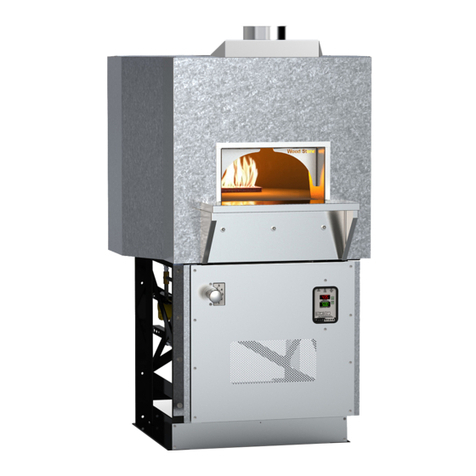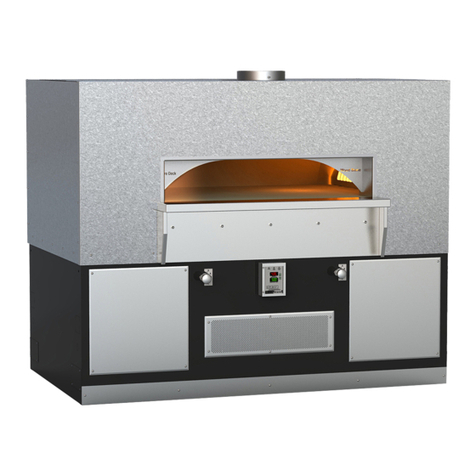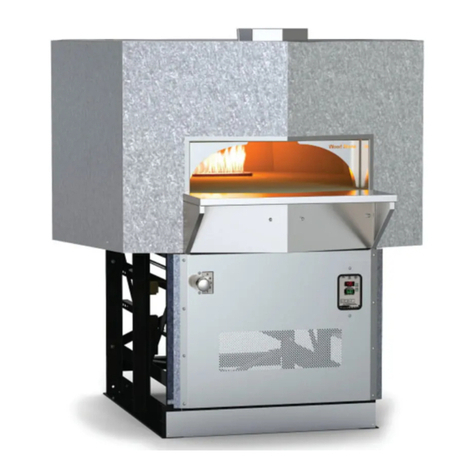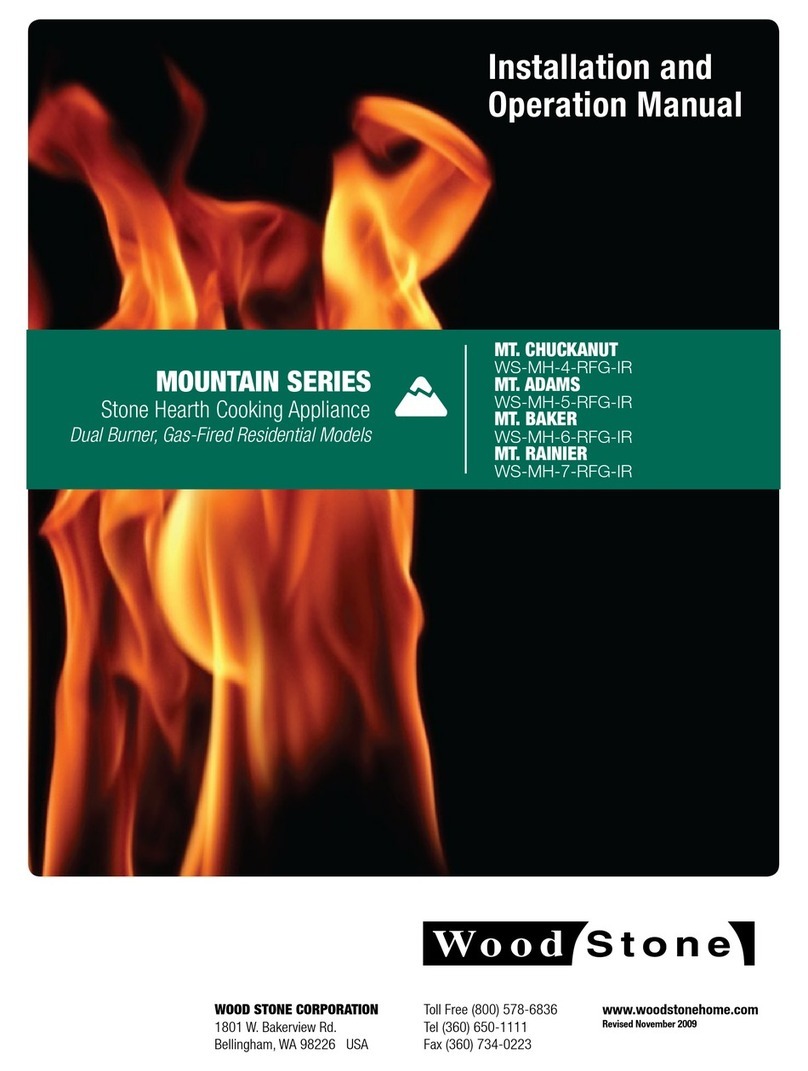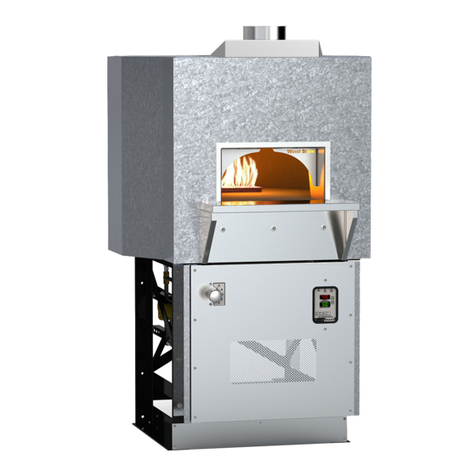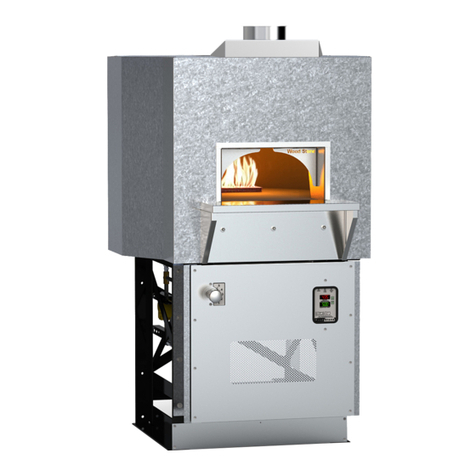
7
An ongoing program of product improvement may require us to change
specifications without notice. FD-9690, FD-11275, FD-11290 and
CS-90-112, Revised June 2015. Doc no: M0041.04
7
wood stone corporation
1801 w. bakerview rd.
bellingham, wa 98226 usa
tf. 800.988.8103
t. 360.650.1111
f. 360.650.1166
FD-9690, 11275, 11290 & CS-90-112
Fire Deck Installation and Operation Manual
Electrical
120 VAC, 4 A, 50/60 Hz
240 VAC, 2 A, 50/60 Hz
All utility connections made underneath
the oven� Shown: Right side burner
configuration� Left side configuration
mirrors right side configuration�
Refer to data plate when installing�
Plan view
Front view Side view
FD-11290 SPECIFICATIONS
VERY IMPORTANT!
Oven is shipped with casters
which add 1-1/2"� Height with
casters to the top of the flue
collar is 87 ¾"� Once the oven
is in place the casters must be
removed�
Utility connections are made
underneath the oven and
indicated on the Plan View to
illustrate geographic location
only�
Shown: Right side burner
configuration� Left side
configuration mirrors right side
configuration�
Shipping weight:
11,500 lbs.
Air intake: Do not
facade or cover over
Must be left
removable for service
UTILITIES SPECIFICATIONS
Gas: 1 inch FNPT gas inlet
347,000 BTU/hr Natural Gas (NG)
or 369,000 BTU/hr Propane (LP)
Optional Decorative Flame
Adds 15,000 BTU/hr
Maximum gas inlet pressure:
1/2 psi (14 inches W�C�)
Venting
The Fire Deck 11290 can be direct connected to a power-ventilated, grease-
rated chimney or can be vented with a Listed Type 1 exhaust hood, or one
constructed in accordance with NFPA 96 and all relevant local and national
codes� The oven must be vented in accordance with all relevant local and
national codes, and in a manner acceptable to the authority having jurisdiction�
IMPORTANT: Ovens with model numbers containing a -W must be vented
as a solid fuel appliance�
REV:
LEGEND:
PART #:
001-5011290-Gas-R
11290 Fire Deck - Gas Right
General Arrangement
5/23/2014 bena
1
DWN BY:
SHEET:
Bellingham, WA 360/650-1111 www.woodstone-corp.com
DIMENSIONS ARE IN INCHES
TOLERANCES: LINEAR ±1/2 [±10mm], ANGULAR ±2°
UNLESS NOTED OTHERWISE
\\woodstone.net\dfs\CAD\0 Pn\WS Top Level\FD-Fire_Deck\FD-11290_General Arrangement-1.dft
THE INFORMATION CONTAINED IN THIS DRAWING IS THE
SOLE PROPERTY OF WOOD STONE CORPORATION
ANY REPRODUCTION OR USE IN PART OR AS A WHOLE
WITHOUT THE WRITTEN PERMISSION OF WOOD STONE IS
PROHIBITED
AN ONGOING PROGRAM OF PRODUCT IMPROVEMENT
MAY REQUIRE US TO CHANGE SPECIFICATIONS
WITHOUT NOTICE.
DATE:
G
120VAC, 4A
GAS INLET: 1" NPT
347,000 BTU, NG
369,000 BTU, LP
1 of 1
AIR INTAKE
AIR INTAKE
G
G
87 3/4"
2230mm
9 3/4"
250mm
59 3/4"
1520mm
108"
2740mm
17 1/2"
440mm
36 3/4"
930mm 5 1/2"
140mm
24"
610mm
74 3/4"
1900mm
48 1/4"
1230mm
31 3/4"
810mm
2 1/4"
50mm
84"
2130mm
33"
840mm
18"
460mm 85 3/4"
2180mm
112 1/4"
2850mm
97 1/2"
7 1/2"
190mm
62 1/4"
1580mm
8 1/4"
210mm
12"
300mm OD
20"
510mm
4"
100mm
27"
690mm
20"
510mm
REV:
LEGEND:
PART #:
001-5011290-Gas-R
11290 Fire Deck - Gas Right
General Arrangement
5/23/2014 bena
1
DWN BY:
SHEET:
Bellingham, WA 360/650-1111 www.woodstone-corp.com
DIMENSIONS ARE IN INCHES
TOLERANCES: LINEAR ±1/2 [±10mm], ANGULAR ±2°
UNLESS NOTED OTHERWISE
\\woodstone.net\dfs\CAD\0 Pn\WS Top Level\FD-Fire_Deck\FD-11290_General Arrangement-1.dft
THE INFORMATION CONTAINED IN THIS DRAWING IS THE
SOLE PROPERTY OF WOOD STONE CORPORATION
ANY REPRODUCTION OR USE IN PART OR AS A WHOLE
WITHOUT THE WRITTEN PERMISSION OF WOOD STONE IS
PROHIBITED
AN ONGOING PROGRAM OF PRODUCT IMPROVEMENT
MAY REQUIRE US TO CHANGE SPECIFICATIONS
WITHOUT NOTICE.
DATE:
G
120VAC, 4A
GAS INLET: 1" NPT
347,000 BTU, NG
369,000 BTU, LP
1 of 1
AIR INTAKE
AIR INTAKE
87 3/4"
2230mm
9 3/4"
250mm
59 3/4"
1520mm
108"
2740mm
17 1/2"
440mm
36 3/4"
930mm 5 1/2"
140mm
24"
610mm
74 3/4"
1900mm
48 1/4"
1230mm
31 3/4"
810mm
2 1/4"
50mm
84"
2130mm
33"
840mm
18"
460mm 85 3/4"
2180mm
112 1/4"
2850mm
97 1/2"
2480mm
7 1/2"
190mm
62 1/4"
1580mm
8 1/4"
210mm
12"
300mm OD
20"
510mm
4"
100mm
15"
380mm
20 3/4"
530mm
27"
690mm
20"
510mm
1 1/2"
40mm
REV:
LEGEND:
PART #:
001-5011290-Gas-R
11290 Fire Deck - Gas Right
General Arrangement
5/23/2014 bena
1
DWN BY:
SHEET:
Bellingham, WA 360/650-1111 www.woodstone-corp.com
DIMENSIONS ARE IN INCHES
TOLERANCES: LINEAR ±1/2 [±10mm], ANGULAR ±2°
UNLESS NOTED OTHERWISE
\\woodstone.net\dfs\CAD\0 Pn\WS Top Level\FD-Fire_Deck\FD-11290_General Arrangement-1.dft
THE INFORMATION CONTAINED IN THIS DRAWING IS THE
SOLE PROPERTY OF WOOD STONE CORPORATION
ANY REPRODUCTION OR USE IN PART OR AS A WHOLE
WITHOUT THE WRITTEN PERMISSION OF WOOD STONE IS
PROHIBITED
AN ONGOING PROGRAM OF PRODUCT IMPROVEMENT
MAY REQUIRE US TO CHANGE SPECIFICATIONS
WITHOUT NOTICE.
DATE:
G
120VAC, 4A
GAS INLET: 1" NPT
347,000 BTU, NG
369,000 BTU, LP
1 of 1
AIR INTAKE
AIR INTAKE
G
G
87 3/4"
2230mm
9 3/4"
250mm
59 3/4"
1520mm
108"
2740mm
17 1/2"
440mm
36 3/4"
930mm 5 1/2"
140mm
24"
610mm
74 3/4"
1900mm
48 1/4"
1230mm
31 3/4"
810mm
2 1/4"
50mm
84"
33"
840mm
18"
460mm 85 3/4"
2180mm
112 1/4"
2850mm
97 1/2"
2480mm
7 1/2"
190mm
62 1/4"
1580mm
8 1/4"
210mm
12"
300mm OD
20"
510mm
4"
100mm
15"
380mm
20 3/4"
530mm
27"
690mm
20"
510mm
1 1/2"
40mm




